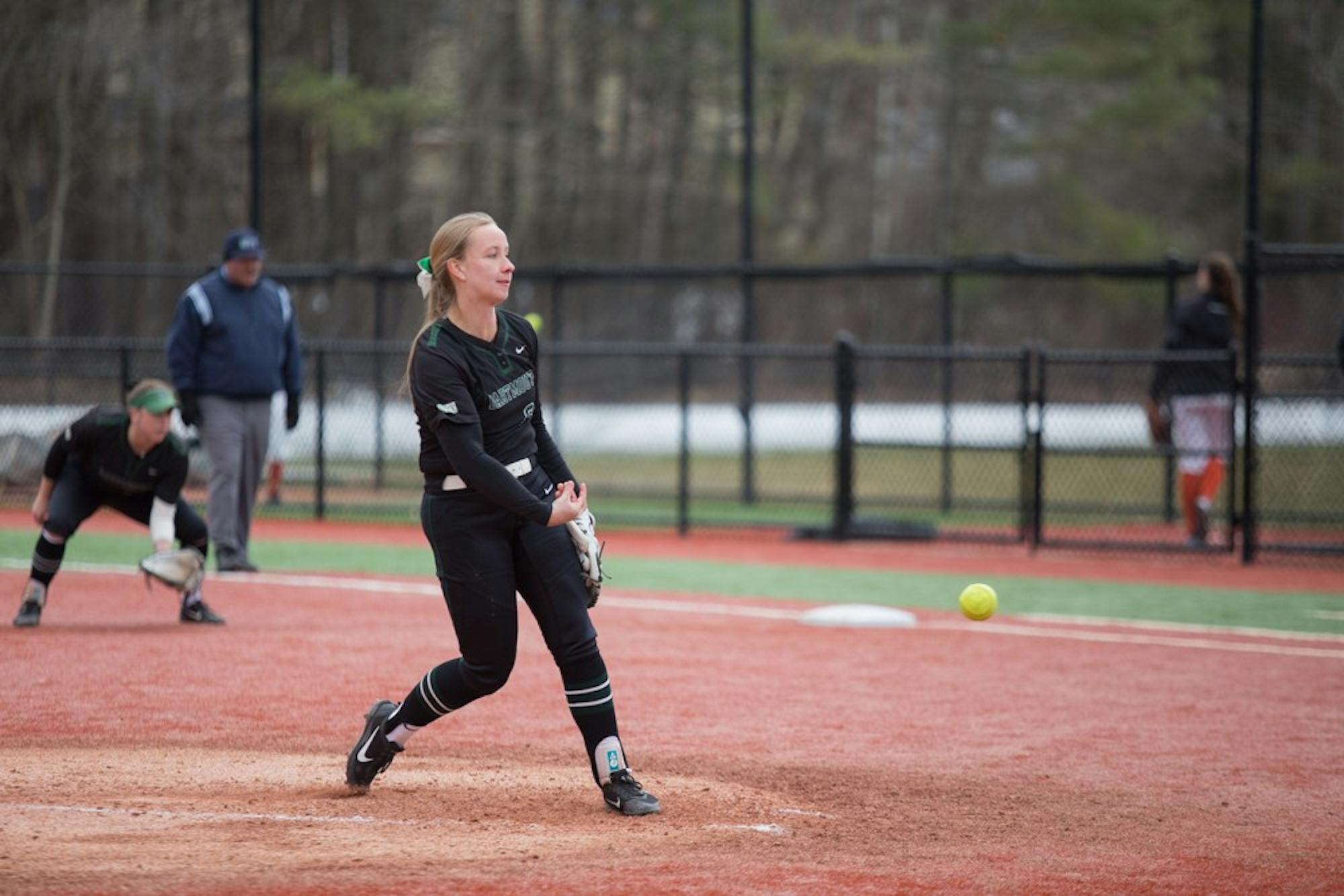Softball

In some sports, roster size matters. The men’s heavyweight rowing team has a roster of 45. The football team numbers more than 100 players. In softball, however, Dartmouth has been playing — and winning — with a stable of just three pitchers. Breanna Ethridge ’18, the only returning pitcher on the squad, is joined in the circle by two freshmen, Morgan Ebow ’20 and Tessa Grossman ’20.
Small rotations are the norm in softball. Dartmouth had four pitchers on its roster in 2015, a number that dipped to three last season. With just a trio of pitchers again this season, Dartmouth has the smallest staff in the Ancient Eight.
But with a weapon like Ethridge, size doesn’t matter. Ethridge has appeared in 24 games and pitched 120.2 innings this season, the most in the conference and 12 more frames than second-place, Columbia University’s Madison Canby. The right-hander ranks seventh in the Ivy League in ERA and is tied for second in opposing batting average.
Ebow has been the team’s other reliable option in the circle, starting 11 of the 12 games Ethridge has not started and appearing in four more. Her first college appearance came in the second game of the season against the then-No. 16 University of Louisiana, Lafayette, one of two nationally ranked teams the Big Green has faced this season.
“It was a little stressful,” Ebow said. “There were definitely nerves coming in, especially pitching my first game against a top 20 team. But the team and the coaches have helped me settle down a lot.”
According to Ethridge, a small pitching staff doesn’t change the team’s approach to the game.
“As pitchers, our job this year isn’t to be a power pitching staff, but rather it is to throw strikes and keep the ball inside the park to let our defense work behind us,” Ethridge said. “One idea [softball head coach Shannon Doepking] preaches to the pitchers is that one good pitch can get you out of anything. Work one pitch at a time, and that one pitch can be the one to get you out of an inning or intense situation.”
Because the underhand style of softball pitching has a lower impact on the arm than an overhand motion, the pitching staff is able to throw almost every day of the week — anywhere from 100 to 300 pitches, according to Ethridge. Given that there are so few pitchers, the staff works to stay healthy and fit. Ethridge, Ebow and Grossman do daily band work and throw long toss to keep their arms loose.
“Even though our arms have a lot more leeway, [they] still feel the stress of pitching as much as we do,” Ethridge said.
With two primary pitchers in tow, Dartmouth could turn to Ethridge or Ebow in any given game, so both stay warm and ready to pitch even when not in the circle.
“It’s really encouraged us to save our arms and be efficient with our pitch counts,” Ebow said. “Keeping the pressure off our arms and getting quick outs is definitely huge this year.”
The team came out of spring break with a 1-18-1 record but has come out strong in Ivy play. With more than half the Ivy League season in the books, the Big Green is 9-3.
“We started off a little slow, but it provided us many opportunities to learn,” Ethridge said. “Without some of the mistakes we made early in the season, it wouldn’t have prepared us for the moments to come when the games are more important. Ivy League play is much more important than any preseason game, and each day is a grind preparing for the games to come.
Baseball

Finishing just short of the Ivy League Championship game last season, the baseball team is hungry for redemption. So far, the Big Green is only two games behind current Red Rolfe Division leader, Yale University, making a return to the Ivy League Championship series a possibility.
The root of this optimism is a seasoned pitching staff. Unlike the softball team, the baseball team has a large arsenal of pitchers from which to choose in various game situations. This cohort of starters, relievers and closers has exhibited both confidence and control on the mound throughout the season. Starter Michael Danielak ’16 credits this to a simple approach.
“One pitch at a time, every time,” Danielak said.
Boasting a 2.28 earned run average through seven starts, Danielak has been one of the team’s workhorse starting pitchers. However, he has focused on each at-bat in the 47.1 innings he has pitched this season.
“[My] pitching philosophy is mostly just attack with the fastball, getting ahead in counts,” Danielak said. “When you’re ahead in counts, the numbers statistically are just enormously in favor of the pitcher.”
The starters, however, are only one part of the equation. Marc Bachman ’18 is one of three left-handed pitchers on the roster and has been pitching primarily out of the bullpen. However, starting and relief pitching require different mindsets.
“In high school, I was always a starting pitcher,” Bachman said. “[Relief pitching is about] coming in usually with runners on base, tight situations.”
Bachman has appeared in 16 of the team’s 30 games, the most appearances by any Dartmouth pitcher. However, he has only pitched 11.2 innings on the season, largely in part because he comes in during strategic situations to face left-handed batters.
“Having multiple left-handed guys can force the other team to a strategy where they might have to hit a right handed hitter,” Bachman said.
As a reliever, the approach of focusing on each pitch individually becomes more important.
“Being able to get guys out from the first pitch, better command of the fastball and developing breaking pitches better” are essential for a relief pitcher, Bachman said.
With four regular starting pitchers on Dartmouth’s roster, each starter has ample time to recover and make plays. But unlike starting pitchers, relievers are not pitching on a set rotation. They pitch in more games and must be prepared to pitch at any point during the game, which makes recovery more challenging.
“[On] days you’re not playing, it is usually pure recovery or getting ready to go for the next day,” Bachman said.
Pitching alone, however, cannot win championships. Currently, Beau Sulser ’16 leads the Ivy League in ERA, and Danielak is third in strikeouts, but no one from Dartmouth is in the top five of the conference for batting average, runs batted in and home runs.
“This year is definitely a different year different team,” said Chris Burkholder ’17, who leads the team with seven saves this season. “Run support this year has been unlike any other in my four years.”
Dartmouth has already exceeded six runs in 15 games this season, more than it did in the any of the last three seasons.
“We have had solid starts from our guys all year and from the bullpen,” Bachman said. “It’s allowed us in situations to be successful. It’s pretty easy with the defense we have behind us.”
There is no question Dartmouth’s bullpen is keeping games competitive and holding opponents at bay. And with continued run support and reliable defense, finishing this season with the Ivy League Championship may be a real possibility.
After hosting Boston College this Tuesday, the team will play a four-game series against Yale, who finished this past weekend 3-1 against Harvard University, on Saturday and Sunday.




